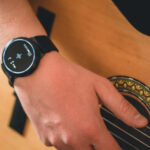Squier Acoustic Guitars are renowned for providing excellent value for beginner to intermediate players. Often, with a few adjustments, these instruments can play and sound even better. This guide walks you through essential setup tweaks to enhance the playability of your Squier acoustic guitar, focusing on action adjustments for improved performance.
Addressing the Nut
The guitar nut plays a crucial role in string spacing and height at the headstock end of the fretboard. While the factory nut on many guitars is functional, it can sometimes be improved. In this case, the original nut was deemed acceptable, though with slightly deep cuts on the high E string and a minor chip on the B string slot. A planned upgrade to a bone nut is a worthwhile enhancement. Bone nuts are favored by many guitarists for their improved tonal qualities and durability compared to synthetic materials. This upgrade is a proactive step towards optimizing both the sound and longevity of the Squier acoustic guitar.
Adjusting Neck Relief
Neck relief refers to the slight bow in the guitar neck, which is essential for comfortable playing and preventing fret buzz. Upon inspection with 11-52 gauge strings, the neck was nearly straight, exhibiting minimal relief. To achieve optimal playability, a slight relief is generally desired. By loosening the truss rod, the neck was adjusted to a relief of 0.010″ measured at the 6th fret, using a capo at the 1st fret and fretting at the 14th fret. This adjustment ensures that the strings have adequate clearance to vibrate freely, contributing to clearer notes and reduced buzzing, especially when playing chords or more aggressively.
Optimizing Saddle Height for Action
The saddle, located on the bridge, directly influences the string height, or “action,” at the higher frets. Initially, the string height at the 13th fret was measured at a high 1/8″ (0.125″) on both the bass and treble sides. To lower the action to a more comfortable level, adjustments to the saddle were necessary. The target action was set between 0.100″ and 0.075″ at the 13th fret.
Initial Saddle Adjustment
Based on the desired action change, a plan was made to remove 0.050″ from the bass side and 0.100″ from the treble side of the saddle – effectively doubling the desired action change at the 13th fret due to the geometry of the guitar. However, in an incremental approach, only half of the planned material was removed initially. This conservative adjustment already resulted in a noticeable improvement in playability, though further reduction was deemed necessary to reach the optimal range.
Further Saddle Refinement
Despite the initial improvement, the action remained slightly higher than desired. The next step involves removing the remaining excess material from the saddle to bring the action into the target range. With a bone saddle also on hand (complementing the bone nut upgrade), there’s flexibility to fine-tune the setup. Having the original saddle to work with provides a baseline and allows for iterative adjustments to achieve perfect action.
Conclusion: Playability and Tone Enhancement
Even with partial adjustments, the Squier acoustic guitar showed significant improvement, particularly due to the properly attached bridge. The enhanced sustain, even before the bone nut and saddle are fully installed, is a promising indicator of further tonal improvements to come. By methodically addressing the nut, neck relief, and saddle height, players can significantly improve the playability and sound of their Squier acoustic guitars, making them even more enjoyable to play.

